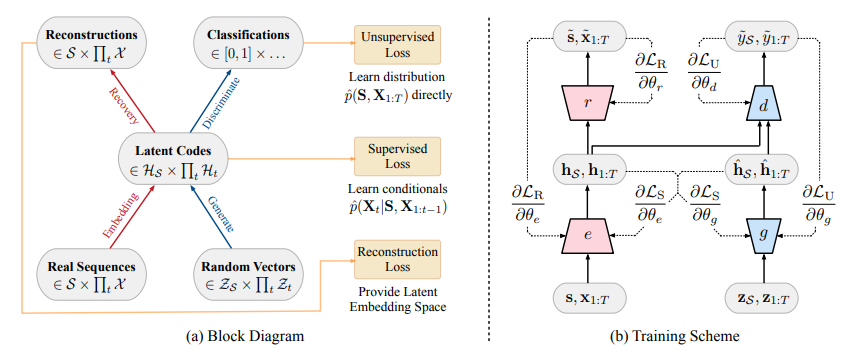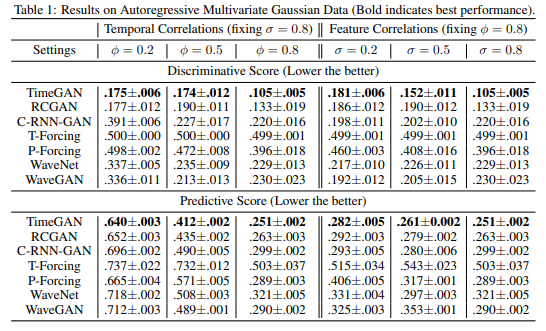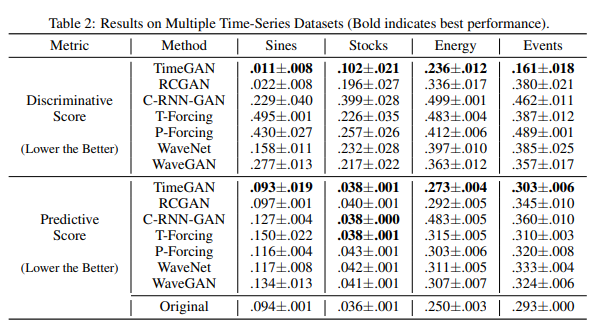Time-series Generative Adversarial Networks: Difference between revisions
No edit summary |
|||
| Line 5: | Line 5: | ||
A time-series model should not only be good at learning the overall distribution of temporal features within different time points, but it should also be good at capturing the dynamic relationship between the temporal variables across time. | A time-series model should not only be good at learning the overall distribution of temporal features within different time points, but it should also be good at capturing the dynamic relationship between the temporal variables across time. | ||
The popular autoregressive approach in time-series or sequence analysis is generally focused on minimizing the error involved in multi-step sampling improving the temporal dynamics of data. In this approach, the distribution of sequences is broken down into a product of conditional probabilities. The deterministic nature of this approach works well for forecasting but it is not very promising in a generative setup. The GAN approach when applied on time-series directly simply tries to learn <math>p(X|t)</math> using generator and discriminator setup but this fails to leverage the prior probabilities like in the case of the autoregressive | The popular autoregressive approach in time-series or sequence analysis is generally focused on minimizing the error involved in multi-step sampling improving the temporal dynamics of data. In this approach, the distribution of sequences is broken down into a product of conditional probabilities. The deterministic nature of this approach works well for forecasting but it is not very promising in a generative setup. The GAN approach when applied on time-series directly simply tries to learn <math>p(X|t)</math> using generator and discriminator setup but this fails to leverage the prior probabilities like in the case of the autoregressive models. | ||
This paper proposes a novel GAN architecture that combines the two approaches (unsupervised GANs and supervised autoregressive) that allow a generative model to have the ability to preserve temporal dynamics along with learning the overall distribution. This mechanism has been termed as '''Time-series Generative Adversarial Network''' or '''TimeGAN'''. To incorporate supervised learning of data into the GAN architecture, this approach makes use of an embedding network that provides a reversible mapping between the temporal features and their latent representations. The key insight of this paper is that the embedding network is trained in parallel with the generator/discriminator network. | This paper proposes a novel GAN architecture that combines the two approaches (unsupervised GANs and supervised autoregressive) that allow a generative model to have the ability to preserve temporal dynamics along with learning the overall distribution. This mechanism has been termed as '''Time-series Generative Adversarial Network''' or '''TimeGAN'''. To incorporate supervised learning of data into the GAN architecture, this approach makes use of an embedding network that provides a reversible mapping between the temporal features and their latent representations. The key insight of this paper is that the embedding network is trained in parallel with the generator/discriminator network. | ||
Revision as of 23:26, 1 December 2020
Presented By
Govind Sharma (20817244)
Introduction
A time-series model should not only be good at learning the overall distribution of temporal features within different time points, but it should also be good at capturing the dynamic relationship between the temporal variables across time.
The popular autoregressive approach in time-series or sequence analysis is generally focused on minimizing the error involved in multi-step sampling improving the temporal dynamics of data. In this approach, the distribution of sequences is broken down into a product of conditional probabilities. The deterministic nature of this approach works well for forecasting but it is not very promising in a generative setup. The GAN approach when applied on time-series directly simply tries to learn [math]\displaystyle{ p(X|t) }[/math] using generator and discriminator setup but this fails to leverage the prior probabilities like in the case of the autoregressive models.
This paper proposes a novel GAN architecture that combines the two approaches (unsupervised GANs and supervised autoregressive) that allow a generative model to have the ability to preserve temporal dynamics along with learning the overall distribution. This mechanism has been termed as Time-series Generative Adversarial Network or TimeGAN. To incorporate supervised learning of data into the GAN architecture, this approach makes use of an embedding network that provides a reversible mapping between the temporal features and their latent representations. The key insight of this paper is that the embedding network is trained in parallel with the generator/discriminator network.
This approach leverages the flexibility of GANs together with the control of the autoregressive model resulting in significant improvements in the generation of realistic time-series.
Related Work
The TimeGAN mechanism combines ideas from different research threads in time-series analysis.
Due to differences between closed-loop training (ground truth conditioned) and open-loop inference (the previous guess conditioned), there can be significant prediction error in multi-step sampling in autoregressive recurrent networks. Different methods have been proposed to remedy this including Scheduled Sampling where models are trained to output based on a combination of ground truth and previous outputs, training and an auxiliary discriminator that helps separate free-running and teacher-forced hidden states accelerating convergence, and Actor-critic methods that condition on target outputs estimating the next-token value that nudges the actor’s free-running predictions. While all these proposed methods try to improve step-sampling, they are still inherently deterministic.
Direct application of GAN architecture on time-series data like C-RNN-GAN or RCGAN try to generate the time-series data recurrently sometimes taking the generated output from the previous step as input (like in case of RCGAN) along with the noise vector. Recently, adding time stamp information for conditioning has also been proposed in these setups to handle inconsistent sampling. But these approaches remain very GAN-centric and depend only on the traditional adversarial feedback (fake/real) to learn which is not sufficient to capture the temporal dynamics.
Problem Formulation
Generally, time-series data can be decomposed into two components: static features (variables that remain the same over long or entire stretches of time) and temporal features (variables that change frequently with time steps). The paper uses [math]\displaystyle{ S }[/math] to denote the static component and [math]\displaystyle{ X }[/math] to denote the temporal features. Using this setting, input to the model can be thought of as a tuple of [math]\displaystyle{ (S, X_{1:t}) }[/math] that has a joint distribution say [math]\displaystyle{ p }[/math]. The objective of a generative model is of course to learn from training data, an approximation of the original distribution [math]\displaystyle{ p(S, X) }[/math] i.e. [math]\displaystyle{ \hat{p}(S, X) }[/math]. Along with this joint distribution, another objective is to simultaneously learn the autoregressive decomposition of [math]\displaystyle{ p(S, X_{1:T}) = p(S)\prod_tp(X_t|S, X_{1:t-1}) }[/math] as well. This gives the following two objective functions.
Proposed Architecture
Apart from the normal GAN components of sequence generator and sequence discriminator, TimeGAN has two additional elements: an embedding function and a recovery function. As mentioned before, all these components are trained concurrently. Figure 1 shows how these four components are arranged and how does information flows between them during training in TimeGAN.
Embedding and Recovery Functions
These functions map between the temporal features and their latent representation. This mapping reduces the dimensionality of the original feature space. Let Hs and Hx denote the latent representations of S and X features in the original space. Therefore, the embedding function has the following form.
And similarly, the recovery function has the following form.
In the paper, these functions have been implemented using a recurrent network for e and a feedforward network for r. These implementation choices are of course subject to parametrization using any architecture.
Sequence Generator and Discriminator
Coming to the conventional GAN components of TimeGAN, there is a sequence generator and a sequence discriminator. But these do not work on the original space, rather the sequence generator uses the random input noise to generate sequences in the latent space. Thus, the generator takes as input the noise vectors [math]\displaystyle{ Z_s }[/math], [math]\displaystyle{ Z_x }[/math] and turns them into a latent representation [math]\displaystyle{ H_s }[/math] and [math]\displaystyle{ H_x }[/math]. This function is implemented using a recurrent network.
The discriminator takes as input the latent representation from the embedding space and produces its binary classification (synthetic/real). This is implemented using a bidirectional recurrent network with a feedforward output layer.
Architecture Workflow
The embedding and recovery functions ought to guarantee an accurate reversible mapping between the feature space and the latent space. After the embedding function turns the original data [math]\displaystyle{ (S, X_{1:t}) }[/math] into the embedding space i.e. [math]\displaystyle{ h_s }[/math], [math]\displaystyle{ h_x }[/math], the recovery function should be able to reconstruct the original data as accurately as possible from this latent representation. Denoting the reconstructed data by [math]\displaystyle{ \tilde{s} }[/math] and [math]\displaystyle{ \tilde{x}_{1:t} }[/math], we get the first objective function of the reconstruction loss:
The generator component in TimeGAN not only gets the noise vector Z as input but it also gets in autoregressive fashion, its previous output i.e. [math]\displaystyle{ h_s }[/math] and [math]\displaystyle{ h_{1:t} }[/math] as input as well. The generator uses these inputs to produce the synthetic embeddings. The unsupervised gradients when computed are used to decreasing the likelihood at the generator and increasing it at the discriminator to provide the correct classification of the produced synthetic output. This is the second objective function in the unsupervised loss form.
As mentioned before, TimeGAN does not rely on only the binary feedback from GANs adversarial component i.e. the discriminator. It also incorporates the supervised loss from the embedding and recovery functions into the fold. To ensure that the two segments of TimeGAN interact with each other, the generator is alternatively fed embeddings of actual data instead of its own previous synthetical produced embedding. Maximizing the likelihood of this produces the third objective i.e. the supervised loss:
Experiments
In the paper, the authors compare TimeGAN with the two most familiar and related variations of traditional GANs applied to time-series i.e. RCGAN and C-RNN-GAN. To make a comparison with autoregressive approaches, the authors use RNNs trained with T-Forcing and P-Forcing. Additionally, performance comparisons are also made with WaveNet and its GAN alternative WaveGAN. Qualitatively, the generated data is examined in terms of diversity (healthy distribution of sample covering real data), fidelity (samples should be indistinguishable from real data) and usefulness (samples should have the same predictive purposes as real data).
The following methods are used for benchmarking and evaluation.
- Visualization: This involves the application of t-SNE and PCA analysis on data (real and synthetic). This is done to compare the distribution of generated data with the real data in 2-D space.
- Discriminative Score: This involves training a post-hoc time-series classification model (an off-the-shelf RNN) to differentiate sequences from generated and original sets.
- Predictive Score: This involves training a post-hoc sequence prediction model to forecast using the generated data and this is evaluated against the real data.
In the first experiment, the authors used time-series sequences from an autoregressive multivariate gaussian data defined as [math]\displaystyle{ x_t=\phi x_{t-1}+n }[/math], where [math]\displaystyle{ n \sim N(0, \sigma 1 + (1-\sigma)I) }[/math]. Table 1 has the results of this experiment performed by different models. The results clearly show how TimeGAN outperforms other methods in terms of both discriminative and predictive scores.
Next, the paper has experimented on different types of Time Series Data. Using time-series sequences of varying properties, the paper evaluates the performance of TimeGAN to testify for its ability to generalize over time-series data. The paper uses datasets like Sines, Stocks, Energy and Events with different methods to see their performance. Figure 2 shows t-SNE/PCA visualization comparison for Sines and Stocks and it is clear from the figure that among all different models, TimeGAN shows the best overlap between generated and original data.
Table 2 shows a comparison of predictive and discriminative scores for different methods across different datasets. And TimeGAN outperforms other methods in both scores indicating a better quality of generated synthetic data across different types of datasets.
Conclusion
Combining the flexibility of GANs and control over conditional temporal dynamics of autoregressive models, TimeGAN shows significant quantitative and qualitative gains for generated time-series data across different varieties of datasets.
The authors indicated potential incorporation of Differential Privacy Frameworks into TimeGAN in future in order to produce realistic time sequences with differential privacy guarantees.



